Devil’s Canyon Review: Intel Core i7-4790K and i5-4690K
by Ian Cutress on July 11, 2014 10:00 AM EST- Posted in
- CPUs
- Intel
- Haswell
- i7
- Overclocking
- Devil's Canyon
- i5
- 4790K
- 4690K
Discrete GPU Gaming
When comparing CPUs to APUs, one strength shown by team Blue in the past is the discrete GPU performance. However even when using dual graphics cards at a 1920x1080p resolution, we seem to have hit a wall where extra CPU performance does not necessarily translate to more frames per second. Our results below show little difference between the Haswell processors, and we need to go down to a 2.0 GHz i7 or a 3.5 GHz i3 CPU to see a significant drop in frame rates. The biggest benefit from overclocking seems to be F1 2013 minimum frame rates.
F1 2013
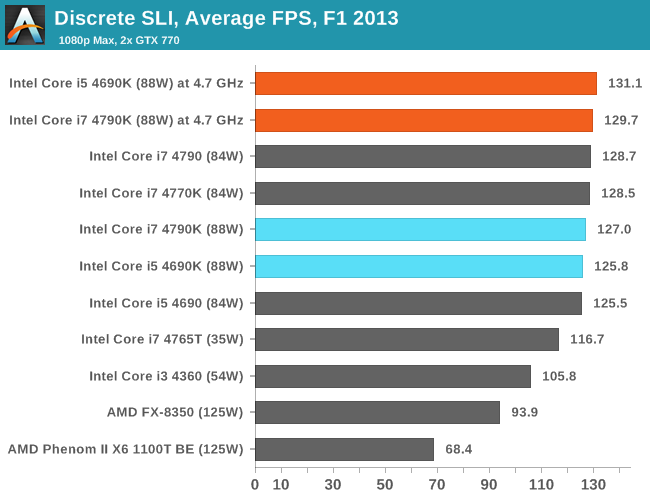

Bioshock Infinite

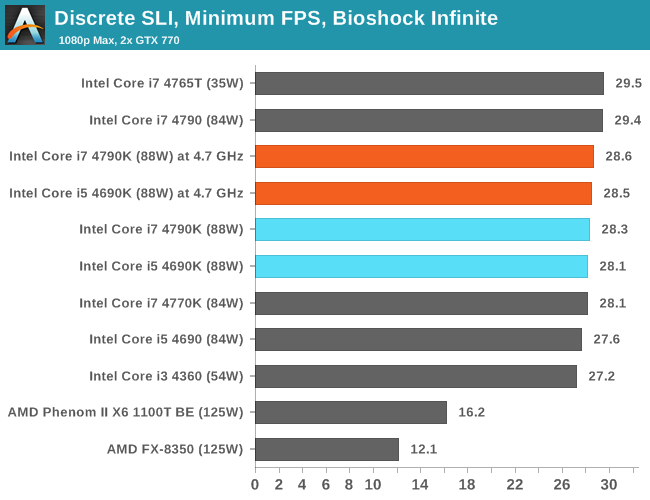
Tomb Raider
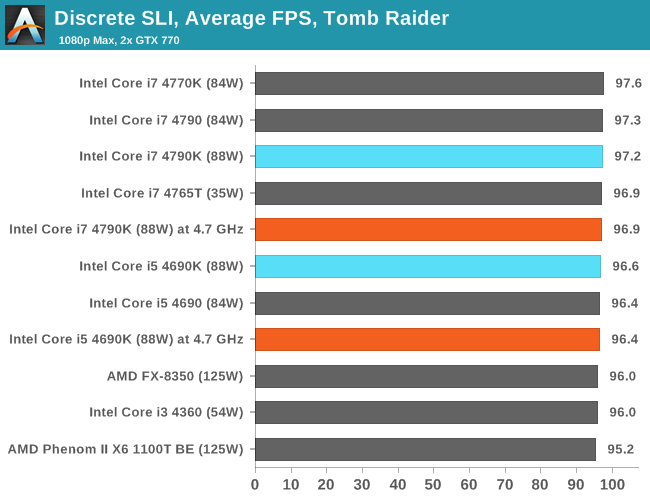
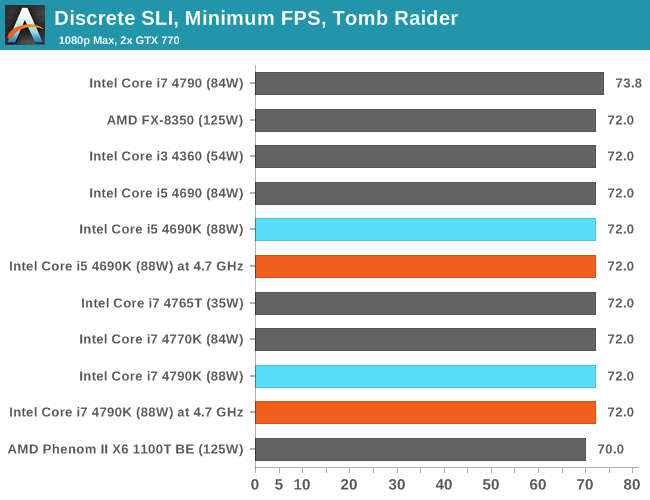
Sleeping Dogs
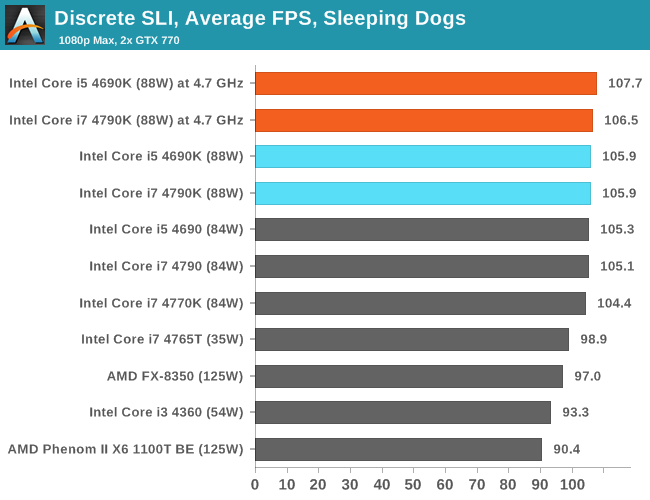
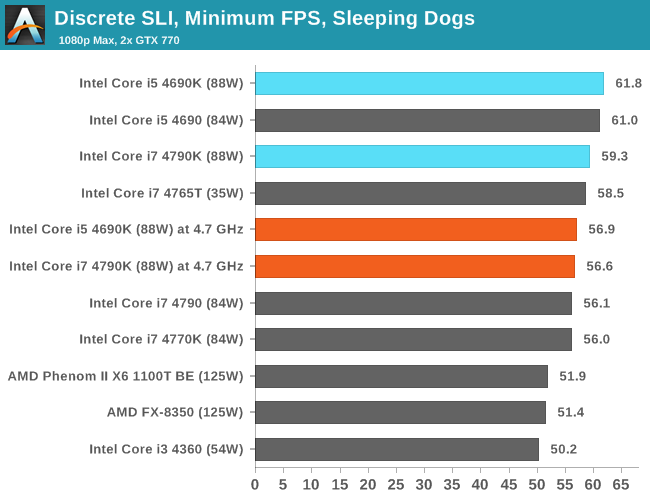
Company of Heroes 2
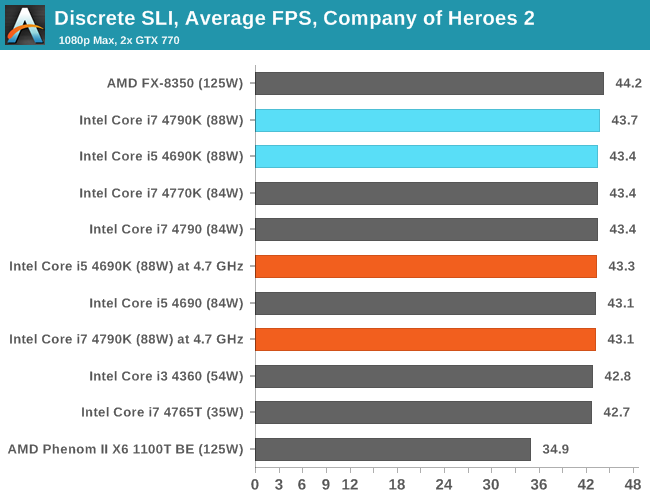

Battlefield 4

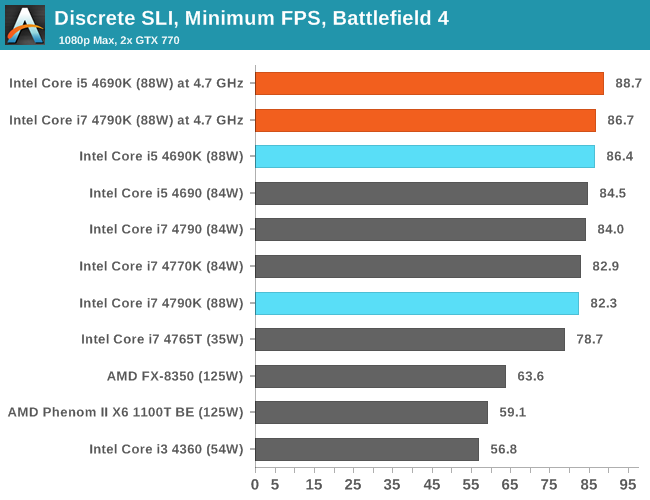










117 Comments
View All Comments
maximumGPU - Friday, July 11, 2014 - link
Thanks for the info!xeizo - Friday, July 11, 2014 - link
I quit overclocking this generation, I have a SB 2600K that does 5GHz+ stable for 24/7 operation if needed and it sits fine in my gaming rig. But, Haswell is interesting exactly for that 24/7 operation thing, I like to have my home server always on and it doubles as a Linux workstation. The lowest end i5 aka 4570S is perfect for that kind of use, very conservative power draw means great opportunities for a silent rig and at the same time snappy enough performance for almost all tasks. I did some bclk on mine so that it turbos to 3.83GHz and it has fast 2133MHz memory. And it is virtually silent and very cool(max 50C at 4x100%). It replaced a Q9450 and was quite a big upgrade in all aspects, so Haswell has it's points other than maximum performance at any cost.My gaming rig waits sceptically for Haswell-E, looks more to be Maxwell frankly speaking ...
jihe - Saturday, July 12, 2014 - link
I quit overclocking when one has to pay a premium to do it. Long live FSB and BCLK overclocks.ZeDestructor - Monday, July 14, 2014 - link
Everything LGA2011 i-series is unlocked ;)Ofc, if you're going there, you have other reasons for doing so, not just overclocking.
PICman - Friday, July 11, 2014 - link
Would you please elaborate on the relationship between outer shell electrons and thermal conductivity? Is more better?Incidentally, polymers have poor thermal conductivity. Nearly all of the thermal flux is due to the filler (composition, concentration, aspect ratio).
ZeDestructor - Friday, July 11, 2014 - link
From what (admittedly little) I know about chemistry, outer-shell electrons don't matter much in thermal conductivity. Not here at least, since they are not free (and thus electron motion heat transfer (can't remember the proper name)isn't possible as in pure metals and alloys). All they would do is change the colour of the TIM as well as other properties of the associated salt (oxides are a specific type of salt).If you check back around Sunday evening/Monday morning, I may update this thread: I have a DnD game with some chemist friends who may be able to answer that question, and well, is a mildly interesting question.
PICman - Friday, July 11, 2014 - link
ZeDestructor, thanks, but I was being sarcastic. Thermal conductivity is much more complex than simply counting valence electrons. Note that a diamond (carbon has 4 valence electrons) is the best solid non-conductive material. Liquids and conductive solids (like silver or copper) are a different story.Ian Cutress - Friday, July 11, 2014 - link
The outer shell d-electrons was more a comment towards color. A number of d10 oxides are used as pigments for paint due to their strong white color. If the ceramic matrix suspension had been something more vibrant, we might be able to pin it down easier. But you don't see any Vanadium based TIMs anywhere :DThermal conductivity usually benefits from rigidity of the material. Hence why diamond is good and a sponge is bad. If you want the best thermal conductivity between the CPU and heatsink, then something like Coollaboratory Liquid Ultra, which uses a binding metal (Gallium, which eats Aluminium - check Youtube for videos) to reform between the two metal surfaces and bind them. This binds the heatspreader to the heatsink (or the die to the heatspreader) without any chance of removal without severe force.
http://www.coollaboratory.com/en/products/liquid-u...
DiDaDaDi - Friday, July 11, 2014 - link
Does anyone knows why 4670k/4770k had TSX/VT-d removed? Of course apart from the obvious reasonDanNeely - Friday, July 11, 2014 - link
They consider it an Enterprise feature and don't want enterprise customers buying cheap consumer CPUs and Overclocking them for more performance when they could force them to buy Xeons for ten times as much.